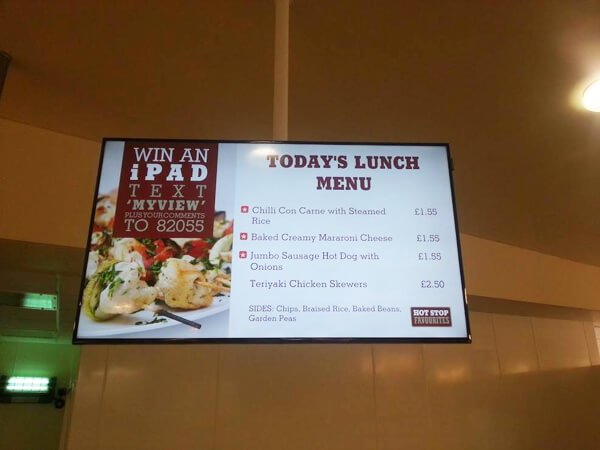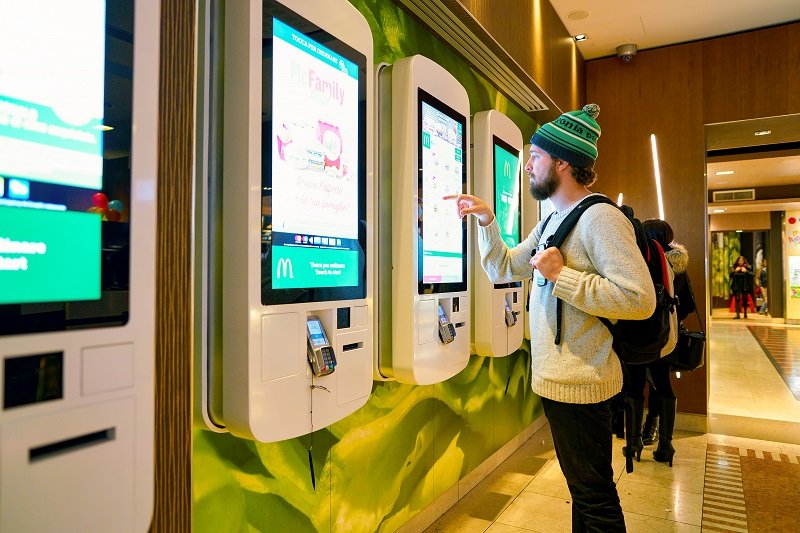Everything You Need To Know About Digital Menus
According to one study, an effective menu display is a top priority for 74% of restaurant customers. Such statistics and a deep understanding of the implications have informed business owners in the dining industry to shift to and optimize digital menus, which continue to prove more effective than traditional ones.
The Evolution of Menus: From Paper to Pixels
There is evidence of restaurant listings in ancient civilizations, but the French coined the word “menu,” and it’s believed that the first printed menu was in Paris. Delmonico’s, a New York City restaurant, was the first establishment in the U.S. to use a menu.

In a nutshell, the evolution of the menu, from plain paper and chalkboard menus to the current and future digital menus, has been an interesting one. The limitations of the static nature of traditional menus, namely the lack of interactivity and being forced to update information manually, were the key drivers behind the shift toward digital menus.
Benefits of Going Digital
Digital menus influence the purchasing decisions of up to 30% of customers in the hospitality industry. The potential increase in sales, alongside other benefits of digital menus for your business and customers, is why you cannot afford not to go digital.
- Enhanced Customer Experience
Digital menus provide detailed information about each menu item, allowing the customers to make an informed decision. The dynamic infotainment, including animated graphics, helps to reduce perceived wait times to your customer’s satisfaction.
- Improved Efficiency
Interactive and user-friendly menus that allow self-order free up your staff so they can attend to other aspects of running your food business. The ease of updating the menus also ensures customers have the latest information on available menu items.
- Potential Cost Savings
With digital menu displays, you eliminate overhead costs related to updating and printing traditional paper menus. These savings can quickly add up over time, especially if you run your food business across multiple locations.
- Enhanced Data Analysis
Collecting and analyzing data from your digital menu boards on what your customers order, their payment methods, and more will help you make better-informed decisions about your overall operations. You will have actionable insights on how to optimize your menu and how to go about your pricing and marketing strategies.
- Brand Reinforcement
The menu screen is perfect for your restaurant to improve its brand visibility and recognition. You can add your brand colors and business logo to your digital menus to boost brand recognition.
Types of Digital Menus and Their Features
Digital menu boards come in several shapes and forms. Each type offers its own features and advantages that render it more suited for specific restaurant concepts and dining settings. Finding a combination of the different menu styles in one establishment is also quite commonplace.
- Static Menus
As the name suggests, these digital menus don’t change. Think of static menus as the traditional menu published on digital menu displays. They aren’t interactive, and customers browse the menu and go ahead to place their orders with staff. The basic concept of static menus and their lack of interactivity make them easy to create, publish, and maintain.
- Interactive Menus

Customers can browse through a touch-responsive interface on their phones or the restaurant’s self-service kiosks through the menu and customize their orders. Some restaurants provide tablets at the table with these interactive menus. By providing detailed descriptions of the various menu items accompanied by visuals such as images, interactive menus drive customer engagement and enhance customer experience.
- QR Code Menus
Customers scan a QR code using their smartphones to access the restaurant’s menu instantly. QR code menus minimize physical contact, something that everyone came to appreciate even more in the wake of the COVID-19 pandemic.
- Mobile Ordering Apps
Customers can browse menus, place and pay for their orders through apps on their phones. Using apps allows for personalized promotion and allows restaurants to run reward programs.
Designing an Engaging Digital Menu
An engaging digital menu will capture the customers’ attention and enhance their dining experience. Designing an engaging digital menu is about having the right content and bringing all the content together in the most effective and visually appealing way.
A few sure-fire tips and tricks to help with digital menu design are as follows.
- Select a font that aligns with your menu board’s colors, visuals, and text length.
- Optimize your color choices
- Use high-quality and appropriate food images
- Use animated or HTML content
- Align menu design with the restaurant theme and concept
- Add interactivity
- Avoid cluttering
The right font and format make it easy for patrons to read your menu even from a distance. The right color mix can influence your customers’ perception of food and their mood and reinforce brand recognition. Similarly, using the right, high-quality images can tantalize your customers’ appetite immediately. Also, interactivity is a critical element of user-friendly menus and enhances customer engagement.
Interactive Elements and Customer Engagement
Touch-screen capabilities, QR code integration, and website and mobile app ordering are some of the top interactive elements you can incorporate into your digital menus. These elements allow patrons to view images and explore detailed information about menu items, enhancing customer engagement.
Customers can also get personalized recommendations that make decision-making all the more easier. Also, customers can place their orders directly, which improves accuracy and eliminates incorrect orders from the wait staff not hearing the order correctly.

Several restaurants, big and small, continue to reap big from leveraging interactive digital menus to elevate customer experience. The self-service kiosks at McDonalds streamline the ordering process, which helps with queue management.
Similarly, Chili’s tabletop tablets streamline the ordering process and allow patrons to use the tablet’s game function to stay entertained while waiting for their orders. The restaurant digital makeover at Baja Bistro is one of our earlier projects at Mvix, and the work put in by our digital menu board design experts continues to pay off to date.
Integration with Point-of-Sale Systems
The seamless integration of digital menu displays with the Point-of-Sale (POS) system improves operational efficiency and customer satisfaction.
This integration automates menu updates, so you only have accurate and up-to-date information on your menu screen. Real-time updates enhance customer experience by eliminating the chances of patrons getting disappointed after ordering menu items that are no longer available.
POS integration also enhances your digital menu’s performance as an upselling tool. You can display complementary menu items in your restaurant, encouraging patrons to add more items to their orders.
Considerations for Implementation
To enjoy all the benefits of digital menus, you need to have a solid implementation strategy in place. Partnering with the right solutions provider can make adopting menu boards in your restaurant a hassle-free experience.
Cost is one of the major considerations. The cost of menu boards covers the technical requirements and services needed. This includes hardware, digital signage software, media players, content creation, installation, and post-installation support and maintenance. The expected return on investment makes this cost of going digital well worth it.
You will also need to integrate your digital menu board with existing systems. Integration with your POS, online ordering, payment processing, and inventory platforms will maximize your digital menu benefits. The Mvix platform has excellent integration capabilities.
The staff will also require training on efficiently using the new technology. A reliable service provider like Mvix will provide demos and train your staff. Your staff can practice with self-order kiosks to improve their understanding and anticipate the kind of concerns and questions customers may have.
Emerging Trends in Digital Menus
Digital menu board technology continues to evolve, and what will be interesting to see is how this evolution revolutionizes customer experiences and improves operational efficiency in restaurants, bars, and other establishments in the food industry.
Interactive menus with dynamic content and real-time updates are one of the stand-out current trends. Among the emerging trends to watch for shortly are as follows.
- Virtual Reality and Augmented Reality
Although very early in development, VR/AR allows customers to enjoy a unique and immersive experience as they view the menu in 3D. These trends provide better customization by allowing customers to change the ingredients and visualize their meals before ordering.
- Voice-activated Menus
Customers can use voice commands to place their orders. In addition to delivering a personalized experience, hands-free ordering through voice commands will benefit customers who can’t use their hands due to disability.
- AI-driven Menu Personalization
Using AI algorithms to analyze customer data sets will allow restaurants to offer personalized menus and recommendations.
- Sustainability Initiatives
Future digital menu displays will likely emphasize using energy-efficient screens like OLED. You will also likely see more digital menus powered by renewable energy sources like solar power.
Navigating Challenges and Future Outlook
The journey to embracing digital menus has its challenges. Resistance to change is one such fundamental challenge. Your staff may be so used to working with traditional menus that they may not readily give the digital menus a chance. This can make staff training and onboarding difficult. The fear of reliability issues due to platform malfunctions and power outages is also a concern. As a business owner, you may also worry about the cost and whether digitizing your menus is a sound financial decision.
Each concern is as valid as the next one. It is, however, important to keep the bigger picture in perspective. Ensuring everyone is on board regarding what benefits you can expect from digital signage will inspire your team to rally their efforts toward maneuvering and overcoming these challenges.
In Conclusion
The shift towards digital menus has revolutionized the dining industry. With clear advantages for customers and the business, it is easy to see why no one wants to be left behind. Future trends in digital menus are expected to transform the dining experience even further, delivering cutting-edge capabilities that will ensure customer satisfaction and improve operational efficiency.
According to one survey, 88% of restaurants said they would consider swapping from traditional physical menus to digital menus. This number has no doubt gone up even as restaurants become more aware of the benefits waiting on the other side of this transition. If you are looking to embrace digital menus to create a more customer-centric and dynamic experience, our experts will gladly walk you through each step of the way.



